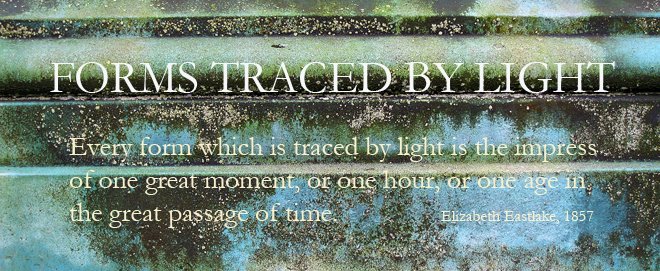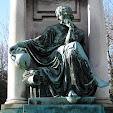Today, to Stockton - a beautiful drive, following the river (I didn't take the 5), full of summer-perfect fields and tree-lined levees (and tractors. UK readers will understand if I say that I've not been able to look at tractors with a straight face, today). Even Stockton itself looks leafy and sunny and not at all like William Coulter's 1884 painting.
Why Stockton? The Haggin Museum is a pretty terrific small museum of nineteenth century art, and well worth the visit. Among other gems ... a new one for my collection of artists who "carve" their names or initials into tree bark: this, believe it or not, is George Inness, in an early painting, Juniata River (1856).
Then this was my favorite bit of lichen, from Thomas Moran's Woodland Temple (1867), which was full of delicately and accurately painted foliage and grasses and tree bark -
in contrast to so many of Albert Bierstadt's, which started to irritate me, en masse, with their slick formulaic qualities - he's one of those artists who reproduces better - small and intense - than he comes across when looked at closely (of course, he's meant to be seen from a bit of a distance, at which point the paintings make an impact again). I hadn't realised quite how many little groups of deer he includes - they somehow always look like the same, not-at-all individualised deer.
And then I got to one of his Barbados paintings, and the wave in this is quite striking different, and excitingly lively.
But what was most fascinating about the museum wasn't the C19th US art, though that's what I'd gone to see, but its status as a Gilded Age collection of European art, especially French and Belgian. Here's Blanche Butterworth Haggin dressed as a Renaissance lady being poled along in a gondola ... painted by Jean-Joseph Benjamin Constant.
The Haggins (I'm talking as if there was just one couple, but there were three, and all went to Europe, and brought art back) - loved animal paintings - there are some Rosa Bonheurs, and a great sheep picture, Highland Monarch (1862) by the Belgian Eugene Verboeckhoven - not exactly the Monarch of the Glen.
A great painting by the Italian, Marco Calderini, with silver birch trunks;
and, quite differently, part of Harry Watrous's Sophistication (c.1908) - which was very unlike so much of the slightly earlier stuff ...
... like these sheep - more sheep - from Giuseppe de Nittis's The Serpentine, Hyde Park, London (c.1874-77);
or these vegetables - sold by an interesting range of ethnic types - in Jean Béraud's Les Halles (1879).
And some tiles, from the Spanish painter Raimundo de Madrazo's The Master Returns - he was also painting in France;
a completely bizarre tangerine colored dyed horse's tail in Jean-Léon Gérôme's The Saddle Bazaar, Cairo (1883);
and then we get to the even weirder ones - another Gérôme, The Artist and His Model (1895), a self-portrait of himself at work on Tanagra - he is sticking his sculpting knife so realistically into the statue's leg ...
Of course there was a Bougereau, with feet and buttocks.
And even after the paintings, the History of Stockton and the San Joaquin valley was well done, too. I've always had a soft spot for room reconstructions, and here's the forge.



















No comments:
Post a Comment